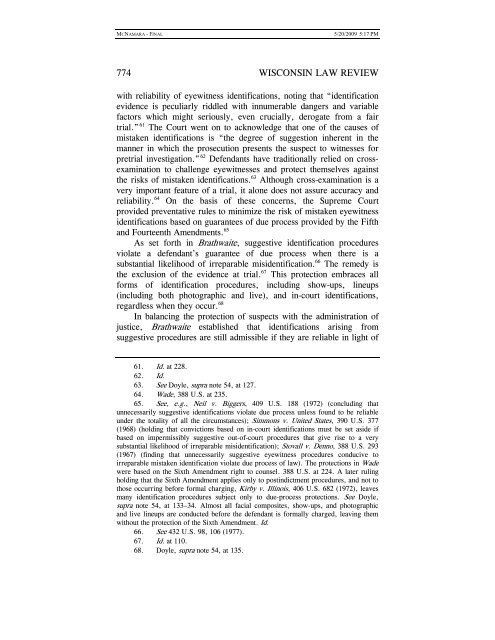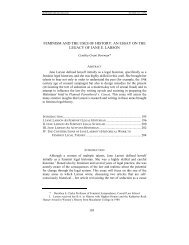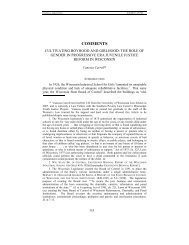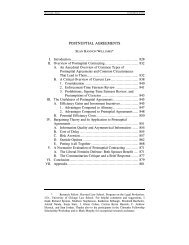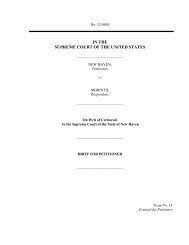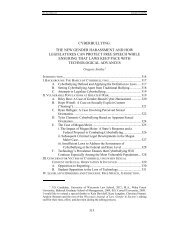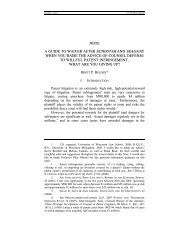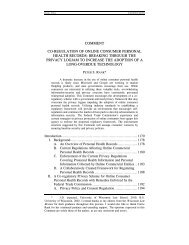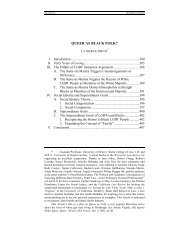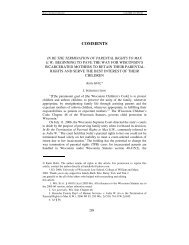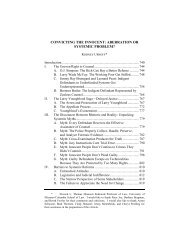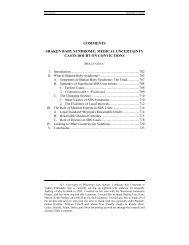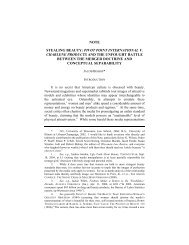comment sketchy eyewitness-identification ... - UW Law School
comment sketchy eyewitness-identification ... - UW Law School
comment sketchy eyewitness-identification ... - UW Law School
Create successful ePaper yourself
Turn your PDF publications into a flip-book with our unique Google optimized e-Paper software.
MCNAMARA - FINAL 5/20/2009 5:17 PM<br />
774 WISCONSIN LAW REVIEW<br />
with reliability of <strong>eyewitness</strong> <strong>identification</strong>s, noting that “<strong>identification</strong><br />
evidence is peculiarly riddled with innumerable dangers and variable<br />
factors which might seriously, even crucially, derogate from a fair<br />
trial.” 61 The Court went on to acknowledge that one of the causes of<br />
mistaken <strong>identification</strong>s is “the degree of suggestion inherent in the<br />
manner in which the prosecution presents the suspect to witnesses for<br />
pretrial investigation.” 62 Defendants have traditionally relied on crossexamination<br />
to challenge <strong>eyewitness</strong>es and protect themselves against<br />
the risks of mistaken <strong>identification</strong>s. 63 Although cross-examination is a<br />
very important feature of a trial, it alone does not assure accuracy and<br />
reliability. 64 On the basis of these concerns, the Supreme Court<br />
provided preventative rules to minimize the risk of mistaken <strong>eyewitness</strong><br />
<strong>identification</strong>s based on guarantees of due process provided by the Fifth<br />
and Fourteenth Amendments. 65<br />
As set forth in Brathwaite, suggestive <strong>identification</strong> procedures<br />
violate a defendant’s guarantee of due process when there is a<br />
substantial likelihood of irreparable mis<strong>identification</strong>. 66 The remedy is<br />
the exclusion of the evidence at trial. 67 This protection embraces all<br />
forms of <strong>identification</strong> procedures, including show-ups, lineups<br />
(including both photographic and live), and in-court <strong>identification</strong>s,<br />
regardless when they occur. 68<br />
In balancing the protection of suspects with the administration of<br />
justice, Brathwaite established that <strong>identification</strong>s arising from<br />
suggestive procedures are still admissible if they are reliable in light of<br />
61. Id. at 228.<br />
62. Id.<br />
63. See Doyle, supra note 54, at 127.<br />
64. Wade, 388 U.S. at 235.<br />
65. See, e.g., Neil v. Biggers, 409 U.S. 188 (1972) (concluding that<br />
unnecessarily suggestive <strong>identification</strong>s violate due process unless found to be reliable<br />
under the totality of all the circumstances); Simmons v. United States, 390 U.S. 377<br />
(1968) (holding that convictions based on in-court <strong>identification</strong>s must be set aside if<br />
based on impermissibly suggestive out-of-court procedures that give rise to a very<br />
substantial likelihood of irreparable mis<strong>identification</strong>); Stovall v. Denno, 388 U.S. 293<br />
(1967) (finding that unnecessarily suggestive <strong>eyewitness</strong> procedures conducive to<br />
irreparable mistaken <strong>identification</strong> violate due process of law). The protections in Wade<br />
were based on the Sixth Amendment right to counsel. 388 U.S. at 224. A later ruling<br />
holding that the Sixth Amendment applies only to postindictment procedures, and not to<br />
those occurring before formal charging, Kirby v. Illinois, 406 U.S. 682 (1972), leaves<br />
many <strong>identification</strong> procedures subject only to due-process protections. See Doyle,<br />
supra note 54, at 133–34. Almost all facial composites, show-ups, and photographic<br />
and live lineups are conducted before the defendant is formally charged, leaving them<br />
without the protection of the Sixth Amendment. Id.<br />
66. See 432 U.S. 98, 106 (1977).<br />
67. Id. at 110.<br />
68. Doyle, supra note 54, at 135.


